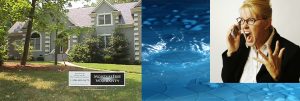The Problem With Stucco Homes
Synthetic stucco is commonly referred to as Exterior Insulating and Finish System (EIFS). Homes with this exterior finish are often strikingly beautiful, offer great flexibility in home design, and provide energy savings. EIFS (usually pronounced “eefs”) constructed homes, however, have a dark cloud surrounding them—allegations of water accumulation and damage resulting in mold growth.
EIFS construction consists of an insulation board secured to the exterior wall surface (e.g., plywood), a durable, water-resistant base coat applied on top of the insulation and reinforced with fiberglass mesh, and a finish coat, which gives the product its stucco-like appearance.
Schedule a stucco inspection in the Charlotte NC Area.
EIFS was developed in post-World War II Germany to repair war-related damage to large buildings. It was introduced in the United States on commercial buildings in the 1970s and on homes in the 1980s. This system is currently applied to approximately 2 percent of residential structures.
The moisture intrusion controversy erupted in 1995, with several EIFS-related lawsuits filed in North Carolina. Homeowners alleged the following:
- Increased level of humidity within the home
- Infestations of termites, ants, and other insects
- Mold, mildew, or fungi growth on the interior walls or on window frames
- Cracking of the drywall
- Cracking, peeling, and bubbling of paint
- Cracking on the EIFS dressing bands around windows
- Delamination—EIFS coming loose from the sheathing of the house
- Rotting of wood trim
- Loss of structural integrity
Growing evidence suggests that once water gets into the EIFS insulation board, it has no way of getting out. Thus, water penetration is not the problem itself, as water can easily penetrate many types of exterior finishes, such as wood and brick. The problem is, according to some civil engineers, water retention. The EIFS system virtually wraps the exterior of the home in an energy-efficient blanket, which promotes energy efficiency but can leave water trapped within.
According to a member of the Georgia Area Home Inspectors in Atlanta, “This product cannot breathe.” He contends that it collects moisture, and the moisture has no way to drain or evaporate.
To counteract these problems, the EIFS industry developed a more drainable type of exterior finish in the last few years. The new “drainable” or “water-managed” system incorporates a secondary moisture barrier and a drainage mat with weep holes in the bottom that allow the escape of water that might get trapped.
Why is a MoistureFree Warranty needed?
Answer: There are a variety of issues surrounding synthetic and hardcoat stucco homes – the negative stigma associated with stucco homes and a reluctance by agents to buy or sell stucco homes are just two. Many of the issues can be mitigated by having a MoistureFree Warranty protecting the home. A MoistureFree Warranty on the home will preserve the home’s value, protect all parties in a stucco sales transaction, and give buyers the peace of mind they need to purchase a stucco home.
Schedule a stucco inspection in the Atlanta GA Area.
What does the MoistureFree Warranty cover?
Answer: The warranty provides payment for repairs related to the stucco if elevated moisture levels are found during the term of the warranty. It pays to modify or repair the affected area so it can be dry again. How can I purchase a warranty? The home must be inspected by a qualified moisture inspector following the MoistureFree Warranty Inspection Protocol. The inspection report then should be submitted to Moisture Warranty Corporation (MWC) for review along with a warranty application form that has been completed by the inspector. MWC professionals will prepare a Certified Repair Analysis (CRA) on the home which details what needs to be done to the home to make it eligible for the warranty. Once these items have been completed, a second inspection is performed to verify repairs have been completed and are correct, and the warranty is issued.
Is the warranty transferable to subsequent homeowners, and can it be renewed at the end of the term?
Answer: Yes. The warranty is fully transferable and can be renewed following a qualifying protocol inspection.
I’ve heard of other warranty/guarantee programs in our area. How do they differ from the MoistureFree Warranty?
Answer: The MoistureFree Warranty is the only national third-party warranty without the potential conflicts of interest inherent with a guarantee from a repair contractor. Without knowing specifics, generally speaking, most other programs are backed by a single insurance policy on the contractor and are not geared to multiple homes. Several large claims can put these companies out of business, leaving the homeowner at the mercy of his/her own pocketbook. In addition, many times these guarantees demand that you use their inspectors and that all repairs are done by those same inspectors. We see this as a potential conflict of interest. At MWC, we give YOU those choices. You choose the inspector, and as long as that inspector uses our inspection protocol, we are able to accept his/her report. You then choose the repair contractor, and as long as repairs are made according to our Repair Standards and Options, we will write the warranty (MWC Inspection Protocol and Repair Standards and Options are available to inspectors and repair contractors who visit our web site). In some states, MWC has the only approved warranty by that state’s insurance commission.
How does having a MoistureFree Warranty affect the sale of a stucco home?
Answer: Having a MoistureFree Warranty can reduce the time the home is on the market by as much as 50%. From 3% to 16% of the sales price can be retained by having a MoistureFree Warranty on the home. On a $250,000 home, that can range from $7,500 up to $40,000 in home value protection at the time of sale. , and here and here and here!




Recent Comments